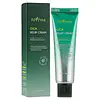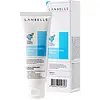What's inside
What's inside
 Key Ingredients
Key Ingredients

 Benefits
Benefits

 Concerns
Concerns

 Ingredients Side-by-side
Ingredients Side-by-side

Water
Skin ConditioningCentella Asiatica Extract
CleansingDipropylene Glycol
HumectantCaprylic/Capric Triglyceride
MaskingGlycerin
HumectantHydrogenated Polydecene
EmollientCetearyl Alcohol
EmollientBeeswax
Emulsion StabilisingCoco-Caprylate/Caprate
Emollient1,2-Hexanediol
Skin ConditioningCetearyl Olivate
Glyceryl Stearate
EmollientLeontopodium Alpinum Callus Culture Extract
AntioxidantMelia Azadirachta Leaf Extract
Skin ConditioningMelia Azadirachta Flower Extract
Skin ConditioningCoccinia Indica Fruit Extract
Skin ConditioningAmber Powder
Solanum Melongena Fruit Extract
Skin ConditioningCurcuma Longa Root Extract
MaskingOcimum Sanctum Leaf Extract
Skin ConditioningCorallina Officinalis Extract
Skin ConditioningHydrogenated Lecithin
EmulsifyingGlyceryl Caprylate
EmollientMoringa Oleifera Seed Oil
EmollientAsiaticoside
AntioxidantSh-Oligopeptide-1
Skin ConditioningAcetyl Hexapeptide-8
HumectantPalmitoyl Tripeptide-1
Skin ConditioningCopper Tripeptide-1
Skin ConditioningPhosphatidylcholine
EmulsifyingPanthenol
Skin ConditioningAllantoin
Skin ConditioningPalmitic Acid
EmollientCetearyl Glucoside
EmulsifyingHydroxyethyl Acrylate/Sodium Acryloyldimethyl Taurate Copolymer
Emulsion StabilisingAdenosine
Skin ConditioningXanthan Gum
EmulsifyingC12-16 Alcohols
EmollientMicrocrystalline Cellulose
AbsorbentCellulose Gum
Emulsion StabilisingDextrin
AbsorbentSorbitan Olivate
EmulsifyingButylene Glycol
HumectantEthylhexylglycerin
Skin ConditioningWater, Centella Asiatica Extract, Dipropylene Glycol, Caprylic/Capric Triglyceride, Glycerin, Hydrogenated Polydecene, Cetearyl Alcohol, Beeswax, Coco-Caprylate/Caprate, 1,2-Hexanediol, Cetearyl Olivate, Glyceryl Stearate, Leontopodium Alpinum Callus Culture Extract, Melia Azadirachta Leaf Extract, Melia Azadirachta Flower Extract, Coccinia Indica Fruit Extract, Amber Powder, Solanum Melongena Fruit Extract, Curcuma Longa Root Extract, Ocimum Sanctum Leaf Extract, Corallina Officinalis Extract, Hydrogenated Lecithin, Glyceryl Caprylate, Moringa Oleifera Seed Oil, Asiaticoside, Sh-Oligopeptide-1, Acetyl Hexapeptide-8, Palmitoyl Tripeptide-1, Copper Tripeptide-1, Phosphatidylcholine, Panthenol, Allantoin, Palmitic Acid, Cetearyl Glucoside, Hydroxyethyl Acrylate/Sodium Acryloyldimethyl Taurate Copolymer, Adenosine, Xanthan Gum, C12-16 Alcohols, Microcrystalline Cellulose, Cellulose Gum, Dextrin, Sorbitan Olivate, Butylene Glycol, Ethylhexylglycerin
Bambusa Vulgaris Water
Skin ConditioningWater
Skin ConditioningGlycerin
HumectantPersea Gratissima Oil
Skin ConditioningSqualane
EmollientHydrogenated Poly(C6-14 Olefin)
EmollientDipropylene Glycol
HumectantCetyl Ethylhexanoate
EmollientCetearyl Alcohol
Emollient1,2-Hexanediol
Skin ConditioningHydrogenated Vegetable Oil
EmollientGlyceryl Stearate
EmollientCeresin
Emulsion StabilisingDioscorea Japonica Root Extract
Skin ConditioningMadecassoside
AntioxidantCopper Tripeptide-1
Skin ConditioningAllantoin
Skin ConditioningPanthenol
Skin ConditioningThymus Vulgaris Extract
PerfumingRosmarinus Officinalis Extract
AntimicrobialOriganum Vulgare Flower/Leaf/Stem Extract
Skin ConditioningLavandula Angustifolia Extract
Skin ConditioningStearic Acid
CleansingCetearyl Olivate
Butylene Glycol
HumectantC12-16 Alcohols
EmollientIsododecane
EmollientSorbitan Olivate
EmulsifyingAmmonium Acryloyldimethyltaurate/Vp Copolymer
Palmitic Acid
EmollientHydrogenated Lecithin
EmulsifyingCetearyl Glucoside
EmulsifyingDimethiconol
EmollientDimethicone/Vinyl Dimethicone Crosspolymer
Skin ConditioningZanthoxylum Piperitum Fruit Extract
Skin ConditioningLonicera Japonica Flower Extract
Skin ConditioningPulsatilla Koreana Extract
Skin ConditioningCitrus Paradisi Fruit Extract
Skin ConditioningCitrus Aurantium Bergamia Fruit Oil
MaskingGlycine
BufferingGlucose
HumectantDisodium EDTA
Bambusa Vulgaris Water, Water, Glycerin, Persea Gratissima Oil, Squalane, Hydrogenated Poly(C6-14 Olefin), Dipropylene Glycol, Cetyl Ethylhexanoate, Cetearyl Alcohol, 1,2-Hexanediol, Hydrogenated Vegetable Oil, Glyceryl Stearate, Ceresin, Dioscorea Japonica Root Extract, Madecassoside, Copper Tripeptide-1, Allantoin, Panthenol, Thymus Vulgaris Extract, Rosmarinus Officinalis Extract, Origanum Vulgare Flower/Leaf/Stem Extract, Lavandula Angustifolia Extract, Stearic Acid, Cetearyl Olivate, Butylene Glycol, C12-16 Alcohols, Isododecane, Sorbitan Olivate, Ammonium Acryloyldimethyltaurate/Vp Copolymer, Palmitic Acid, Hydrogenated Lecithin, Cetearyl Glucoside, Dimethiconol, Dimethicone/Vinyl Dimethicone Crosspolymer, Zanthoxylum Piperitum Fruit Extract, Lonicera Japonica Flower Extract, Pulsatilla Koreana Extract, Citrus Paradisi Fruit Extract, Citrus Aurantium Bergamia Fruit Oil, Glycine, Glucose, Disodium EDTA
Ingredients Explained
These ingredients are found in both products.
Ingredients higher up in an ingredient list are typically present in a larger amount.
1,2-Hexanediol is a synthetic liquid and another multi-functional powerhouse.
It is a:
- Humectant, drawing moisture into the skin
- Emollient, helping to soften skin
- Solvent, dispersing and stabilizing formulas
- Preservative booster, enhancing the antimicrobial activity of other preservatives
Allantoin is a soothing ingredient known for its protective and moisturizingg properties. Because of this, it is often added to products with strong active ingredients.
Studies show higher concentrations of this ingredient can promote wound healing.
Though it can be derived from the comfrey plant, allantoin is produced synthetically for cosmetic products to ensure purity.
Learn more about AllantoinButylene Glycol (or BG) is used within cosmetic products for a few different reasons:
Overall, Butylene Glycol is a safe and well-rounded ingredient that works well with other ingredients.
Though this ingredient works well with most skin types, some people with sensitive skin may experience a reaction such as allergic rashes, closed comedones, or itchiness.
Learn more about Butylene GlycolWe don't have a description for C12-16 Alcohols yet.
Cetearyl alcohol is a mixture of two fatty alcohols: cetyl alcohol and stearyl alcohol. It is mainly used as an emulsifier. Emulsifiers help prevent the separation of oils and products. Due to its composition, it can also be used to thicken a product or help create foam.
Cetearyl alcohol is an emollient. Emollients help soothe and hydrate the skin by trapping moisture.
Studies show Cetearyl alcohol is non-toxic and non-irritating. The FDA allows products labeled "alcohol-free" to have fatty alcohols.
This ingredient is usually derived from plant oils such as palm, vegetable, or coconut oils. There is debate on whether this ingredient will cause acne.
Due to the fatty acid base, this ingredient may not be Malassezia folliculitis safe.
Learn more about Cetearyl AlcoholCetearyl Glucoside is a surfactant and emulsifier. It can be produced from synthetic of natural sources of cetearyl alcohol and glucose.
Emulsifiers help prevent ingredients from separating, such as oils and waters. It can also be used to enhance the texture of products.
As a surfactant, Cetearyl Glucoside helps during the cleansing process. By gathering all the dirt and oils, it allows these molecules to be washed away easily.
Learn more about Cetearyl GlucosideCetearyl Olivate is an emulsifier and texture enhancer. It is derived from the fatty acids of olive oil and Cetearyl alcohol, and is biodegradable.
As an emulsifier, it is used to prevent oils and waters from separating. It can also
Manufacturers use the name Olivem 1000. This ingredient has been found to preserve the natural microbiome of skin. Having a healthy microbiome helps keep our skin healthy and protects against harmful bacteria. This ingredient is grouped with Sorbitan Olivate under the name Olivem 1000.
Learn more about Cetearyl OlivateCopper Tripeptide-1 (GHK-Cu) is a skin repairing ingredient known for its ability to boost collagen, improve firmness, and support skin regeneration.
It is a complex made up of a naturally occurring peptide (glycine-histidine-lysine) and copper, an essential trace element.
While studying wound healing, researchers noticed GHK-Cu stimulated hair follicle enlargement and growth by keeping hair in its active growth phase longer. This has made it a promising ingredient for hair regrowth treatments.
Some people have reported increased facial hair. While GHK-Cu can make your hair follicles bigger, it usually doesn’t turn soft, barely-visible facial hairs into thick, dark ones.
Anecdotal reports suggest that overusing copper peptides might lead to premature aging due to excess free copper or enzyme imbalances. This claim isn’t backed by large-scale studies.
Unfortunately, there are limited human studies for this ingredient. While early results are promising, many studies are either small, in-vitro, or not rigorously controlled.
For example, there is a 1998 study that explored the effects of copper tripeptide, vitamin C, tretinoin, and melatonin on skin repair and collagen synthesis.
After one month, increased procollagen production was seen in 7 out of 10 participants using copper tripeptide (more than those using vitamin C, melatonin, or tretinoin.
While the study was exploratory, it offers early evidence that copper tripeptide may support collagen production. Larger, well-designed trials are still needed to confirm its potential and understand individual responses.
Read more about other common types of peptides here:
Learn more about Copper Tripeptide-1Dipropylene Glycol is a synthetically created humectant, stabilizer, and solvent.
This ingredient helps:
Dipropylene glycol is technically an alcohol, but it belongs to the glycol family (often considered part of the ‘good’ alcohols). This means it is hydrating and gentle on skin unlike drying solvent alcohols like denatured alcohol.
As a masking agent, Dipropylene Glycol can be used to cover the smell of other ingredients. However, it does not have a scent.
Studies show Dipropylene Glycol is considered safe to use in skincare.
Learn more about Dipropylene GlycolGlycerin is already naturally found in your skin. It helps moisturize and protect your skin.
A study from 2016 found glycerin to be more effective as a humectant than AHAs and hyaluronic acid.
As a humectant, it helps the skin stay hydrated by pulling moisture to your skin. The low molecular weight of glycerin allows it to pull moisture into the deeper layers of your skin.
Hydrated skin improves your skin barrier; Your skin barrier helps protect against irritants and bacteria.
Glycerin has also been found to have antimicrobial and antiviral properties. Due to these properties, glycerin is often used in wound and burn treatments.
In cosmetics, glycerin is usually derived from plants such as soybean or palm. However, it can also be sourced from animals, such as tallow or animal fat.
This ingredient is organic, colorless, odorless, and non-toxic.
Glycerin is the name for this ingredient in American English. British English uses Glycerol/Glycerine.
Learn more about GlycerinGlyceryl Stearate is a mix of glycerin and stearic acid.
It is used to stabilize the mixing of water and oil ingredients. By preventing these ingredients from separating, it can help elongate shelf life. It can also help thicken the product's texture.
As an emollient, it helps soften skin and supports barrier-replenishing ingredients.
In cosmetics, Glyceryl Stearate is often made from vegetable oils or synthetically produced.
This ingredient may not be fungal-acne safe
Fun fact: The human body also creates Glyceryl Stearate naturally.
Learn more about Glyceryl StearateHydrogenated Lecithin is created from the hydrogenation of lecithin (a group of phospholipids). Hydrogenation is a chemical reaction between hydrogen and another element.
This ingredient is an emollient and emulsifier. As an emollient, it helps soften skin by trapping moisture within. As an emulsifier, it prevents oil and water ingredients from separating.
Palmitic Acid is a fatty acid naturally found in our skin and in many plant and animal sources. In cosmetics, it is usually derived from palm oil. It serves many purposes in skincare, acting as a cleanser, emollient, and emulsifier.
As an emollient, palmitic acid helps soften and smooth the skin by preventing water loss. In cleansers, it helps remove oil and dirt while creating foam.
Its emulsifying properties help stabilize products by keeping water and oil-based ingredients from separating.
This may not be suitable for fungal acne-prone skin, as fatty acids like this can sometimes trigger breakouts in sensitive individuals.
Learn more about Palmitic AcidPanthenol is a common ingredient that helps hydrate and soothe the skin. It is found naturally in our skin and hair.
There are two forms of panthenol: D and L.
D-panthenol is also known as dexpanthenol. Most cosmetics use dexpanthenol or a mixture of D and L-panthenol.
Panthenol is famous due to its ability to go deeper into the skin's layers. Using this ingredient has numerous pros (and no cons):
Like hyaluronic acid, panthenol is a humectant. Humectants are able to bind and hold large amounts of water to keep skin hydrated.
This ingredient works well for wound healing. It works by increasing tissue in the wound and helps close open wounds.
Once oxidized, panthenol converts to pantothenic acid. Panthothenic acid is found in all living cells.
This ingredient is also referred to as pro-vitamin B5.
Learn more about PanthenolSorbitan Olivate is created from the fatty acids in olive oil and sorbitol.
This ingredient is an oil in water emulsifier. It helps stabilize a product by preventing oils and waters from separating. Sorbitan Olivate also helps hydrate the skin.
Manufacturers sell sorbitan olivate under the name OliveM 1000. OliveM 1000 a multifunctional ingredient. It is self-emulsifying. According to a manufacturer, OliveM 1000 does not disrupt natural skin biome.
Due to its olive oil base, this ingredient may not be fungal-acne safe.
Learn more about Sorbitan OlivateWater. It's the most common cosmetic ingredient of all. You'll usually see it at the top of ingredient lists, meaning that it makes up the largest part of the product.
So why is it so popular? Water most often acts as a solvent - this means that it helps dissolve other ingredients into the formulation.
You'll also recognize water as that liquid we all need to stay alive. If you see this, drink a glass of water. Stay hydrated!
Learn more about Water